sensor LINCOLN MKZ 2014 User Guide
[x] Cancel search | Manufacturer: LINCOLN, Model Year: 2014, Model line: MKZ, Model: LINCOLN MKZ 2014Pages: 468, PDF Size: 4.49 MB
Page 52 of 468
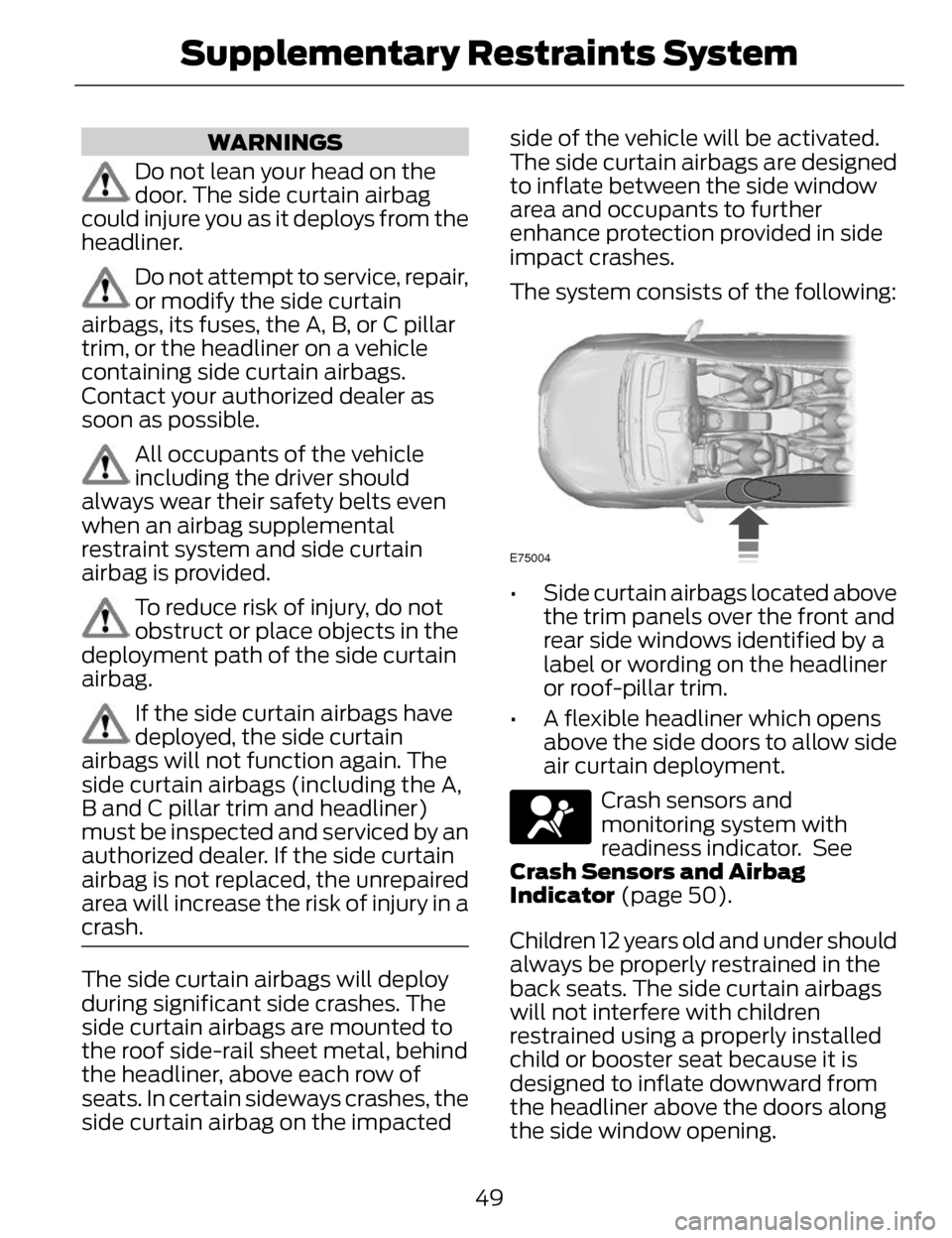
WARNINGS
Do not lean your head on the
door. The side curtain airbag
could injure you as it deploys from the
headliner.
Do not attempt to service, repair,
or modify the side curtain
airbags, its fuses, the A, B, or C pillar
trim, or the headliner on a vehicle
containing side curtain airbags.
Contact your authorized dealer as
soon as possible.
All occupants of the vehicle
including the driver should
always wear their safety belts even
when an airbag supplemental
restraint system and side curtain
airbag is provided.
To reduce risk of injury, do not
obstruct or place objects in the
deployment path of the side curtain
airbag.
If the side curtain airbags have
deployed, the side curtain
airbags will not function again. The
side curtain airbags (including the A,
B and C pillar trim and headliner)
must be inspected and serviced by an
authorized dealer. If the side curtain
airbag is not replaced, the unrepaired
area will increase the risk of injury in a
crash.
The side curtain airbags will deploy
during significant side crashes. The
side curtain airbags are mounted to
the roof side-rail sheet metal, behind
the headliner, above each row of
seats. In certain sideways crashes, the
side curtain airbag on the impacted side of the vehicle will be activated.
The side curtain airbags are designed
to inflate between the side window
area and occupants to further
enhance protection provided in side
impact crashes.
The system consists of the following:
E75004
• Side curtain airbags located above
the trim panels over the front and
rear side windows identified by a
label or wording on the headliner
or roof-pillar trim.
• A flexible headliner which opens above the side doors to allow side
air curtain deployment.
Crash sensors and
monitoring system with
readiness indicator. See
Crash Sensors and Airbag
Indicator (page 50).
Children 12 years old and under should
always be properly restrained in the
back seats. The side curtain airbags
will not interfere with children
restrained using a properly installed
child or booster seat because it is
designed to inflate downward from
the headliner above the doors along
the side window opening.
49
Supplementary Restraints System
Page 53 of 468
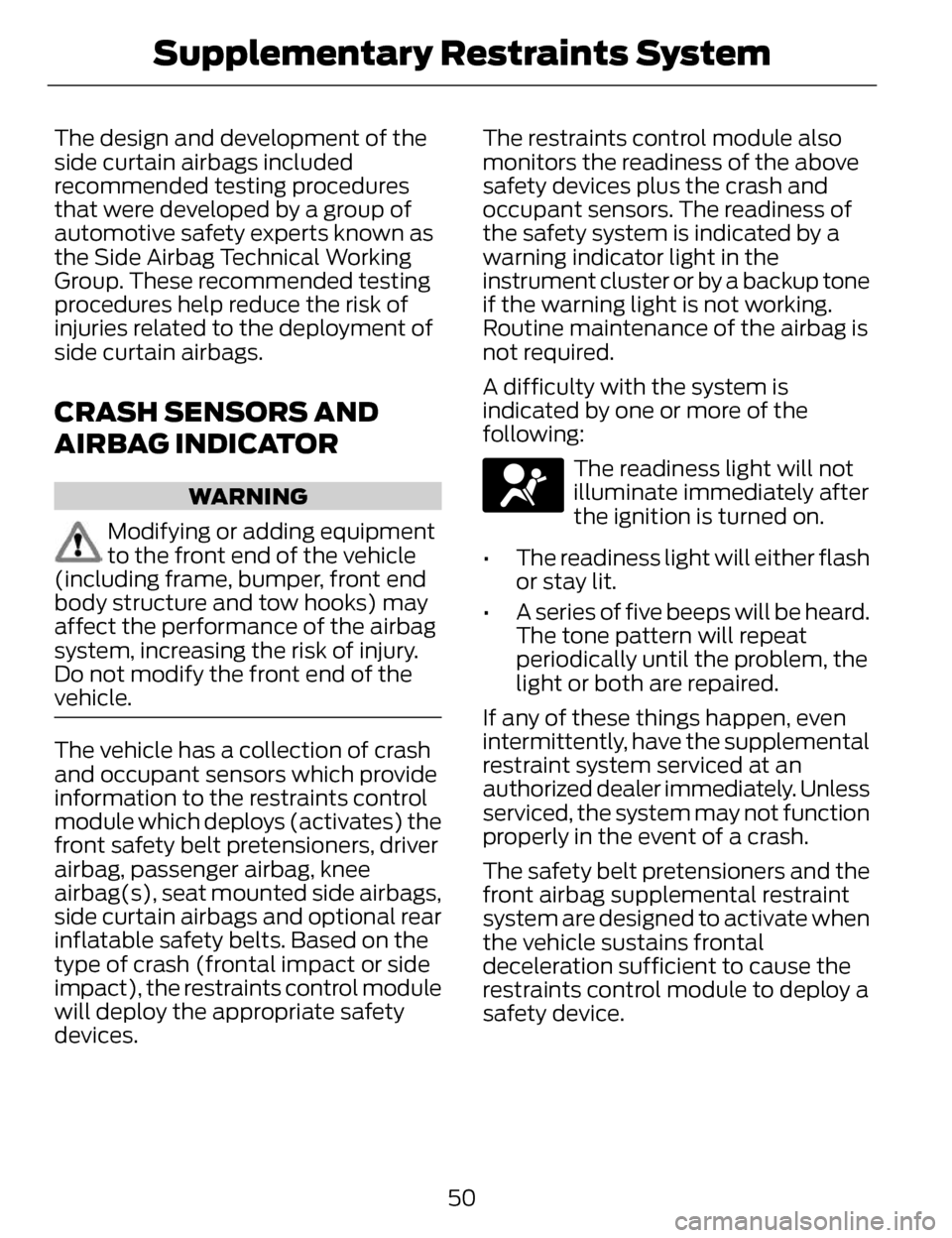
The design and development of the
side curtain airbags included
recommended testing procedures
that were developed by a group of
automotive safety experts known as
the Side Airbag Technical Working
Group. These recommended testing
procedures help reduce the risk of
injuries related to the deployment of
side curtain airbags.
CRASH SENSORS AND
AIRBAG INDICATOR
WARNING
Modifying or adding equipment
to the front end of the vehicle
(including frame, bumper, front end
body structure and tow hooks) may
affect the performance of the airbag
system, increasing the risk of injury.
Do not modify the front end of the
vehicle.
The vehicle has a collection of crash
and occupant sensors which provide
information to the restraints control
module which deploys (activates) the
front safety belt pretensioners, driver
airbag, passenger airbag, knee
airbag(s), seat mounted side airbags,
side curtain airbags and optional rear
inflatable safety belts. Based on the
type of crash (frontal impact or side
impact), the restraints control module
will deploy the appropriate safety
devices. The restraints control module also
monitors the readiness of the above
safety devices plus the crash and
occupant sensors. The readiness of
the safety system is indicated by a
warning indicator light in the
instrument cluster or by a backup tone
if the warning light is not working.
Routine maintenance of the airbag is
not required.
A difficulty with the system is
indicated by one or more of the
following:
The readiness light will not
illuminate immediately after
the ignition is turned on.
• The readiness light will either flash or stay lit.
• A series of five beeps will be heard. The tone pattern will repeat
periodically until the problem, the
light or both are repaired.
If any of these things happen, even
intermittently, have the supplemental
restraint system serviced at an
authorized dealer immediately. Unless
serviced, the system may not function
properly in the event of a crash.
The safety belt pretensioners and the
front airbag supplemental restraint
system are designed to activate when
the vehicle sustains frontal
deceleration sufficient to cause the
restraints control module to deploy a
safety device.
50
Supplementary Restraints System
Page 66 of 468
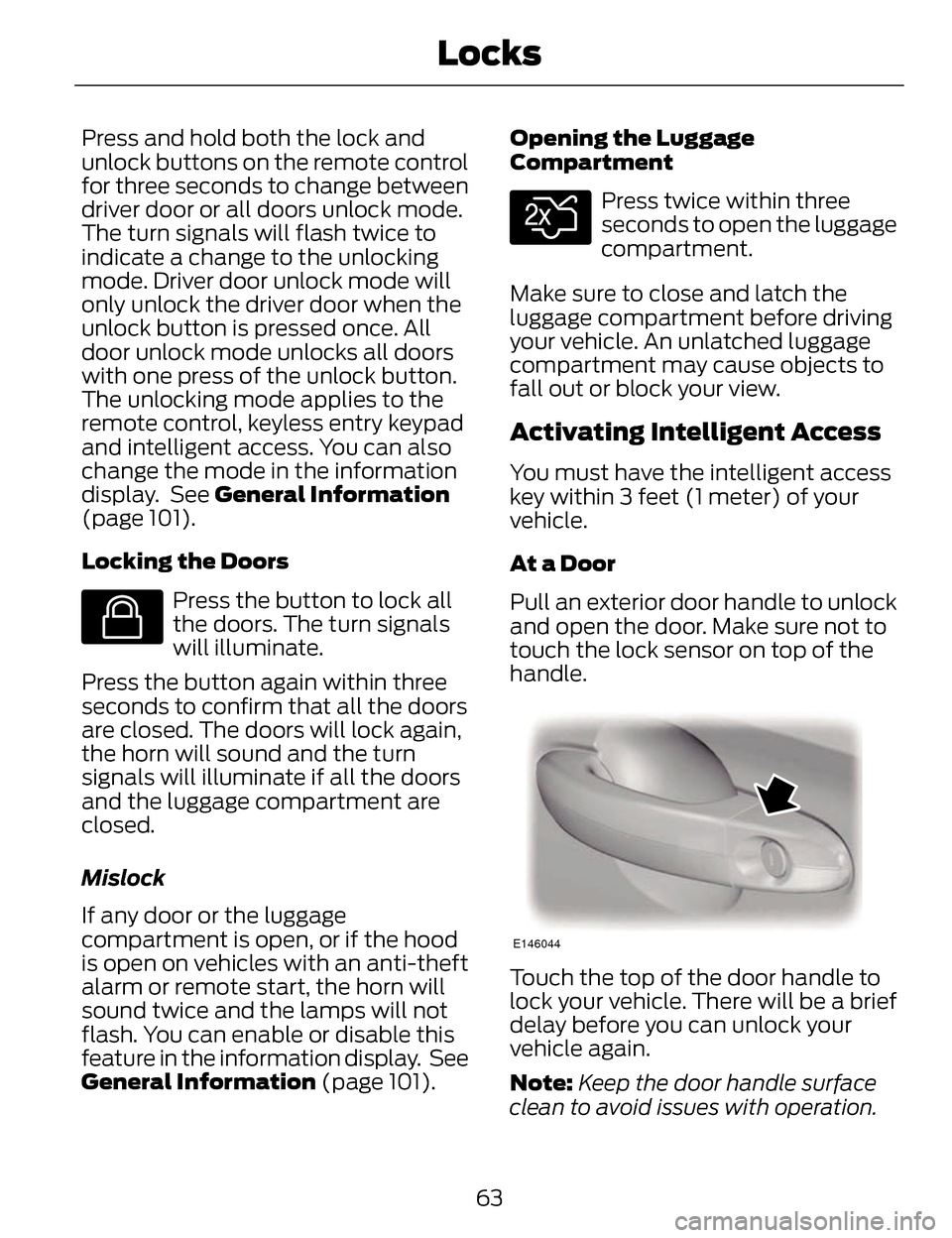
Press and hold both the lock and
unlock buttons on the remote control
for three seconds to change between
driver door or all doors unlock mode.
The turn signals will flash twice to
indicate a change to the unlocking
mode. Driver door unlock mode will
only unlock the driver door when the
unlock button is pressed once. All
door unlock mode unlocks all doors
with one press of the unlock button.
The unlocking mode applies to the
remote control, keyless entry keypad
and intelligent access. You can also
change the mode in the information
display. See General Information
(page 101).
Locking the Doors
E138623
Press the button to lock all
the doors. The turn signals
will illuminate.
Press the button again within three
seconds to confirm that all the doors
are closed. The doors will lock again,
the horn will sound and the turn
signals will illuminate if all the doors
and the luggage compartment are
closed.
Mislock
If any door or the luggage
compartment is open, or if the hood
is open on vehicles with an anti-theft
alarm or remote start, the horn will
sound twice and the lamps will not
flash. You can enable or disable this
feature in the information display. See
General Information (page 101). Opening the Luggage
Compartment
E138630
Press twice within three
seconds to open the luggage
compartment.
Make sure to close and latch the
luggage compartment before driving
your vehicle. An unlatched luggage
compartment may cause objects to
fall out or block your view.
Activating Intelligent Access
You must have the intelligent access
key within 3 feet (1 meter) of your
vehicle.
At a Door
Pull an exterior door handle to unlock
and open the door. Make sure not to
touch the lock sensor on top of the
handle.
E146044
Touch the top of the door handle to
lock your vehicle. There will be a brief
delay before you can unlock your
vehicle again.
Note: Keep the door handle surface
clean to avoid issues with operation.
63
Locks
Page 83 of 468
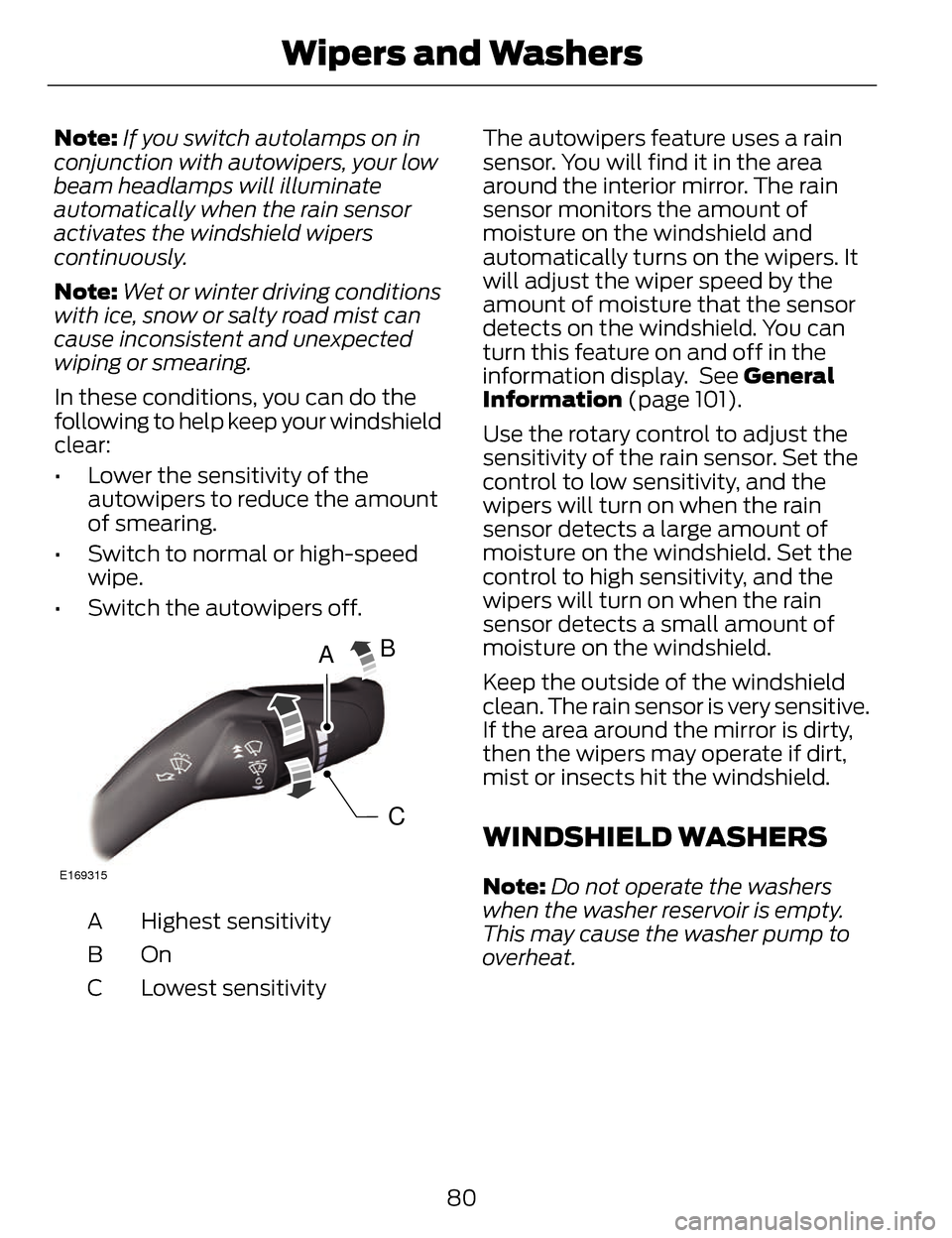
Note:If you switch autolamps on in
conjunction with autowipers, your low
beam headlamps will illuminate
automatically when the rain sensor
activates the windshield wipers
continuously.
Note: Wet or winter driving conditions
with ice, snow or salty road mist can
cause inconsistent and unexpected
wiping or smearing.
In these conditions, you can do the
following to help keep your windshield
clear:
• Lower the sensitivity of the autowipers to reduce the amount
of smearing.
• Switch to normal or high-speed wipe.
• Switch the autowipers off.
A
C
B
E169315
Highest sensitivity
A
OnB
Lowest sensitivity
C The autowipers feature uses a rain
sensor. You will find it in the area
around the interior mirror. The rain
sensor monitors the amount of
moisture on the windshield and
automatically turns on the wipers. It
will adjust the wiper speed by the
amount of moisture that the sensor
detects on the windshield. You can
turn this feature on and off in the
information display. See General
Information (page 101).
Use the rotary control to adjust the
sensitivity of the rain sensor. Set the
control to low sensitivity, and the
wipers will turn on when the rain
sensor detects a large amount of
moisture on the windshield. Set the
control to high sensitivity, and the
wipers will turn on when the rain
sensor detects a small amount of
moisture on the windshield.
Keep the outside of the windshield
clean. The rain sensor is very sensitive.
If the area around the mirror is dirty,
then the wipers may operate if dirt,
mist or insects hit the windshield.
WINDSHIELD WASHERS
Note:
Do not operate the washers
when the washer reservoir is empty.
This may cause the washer pump to
overheat.
80
Wipers and Washers
Page 86 of 468
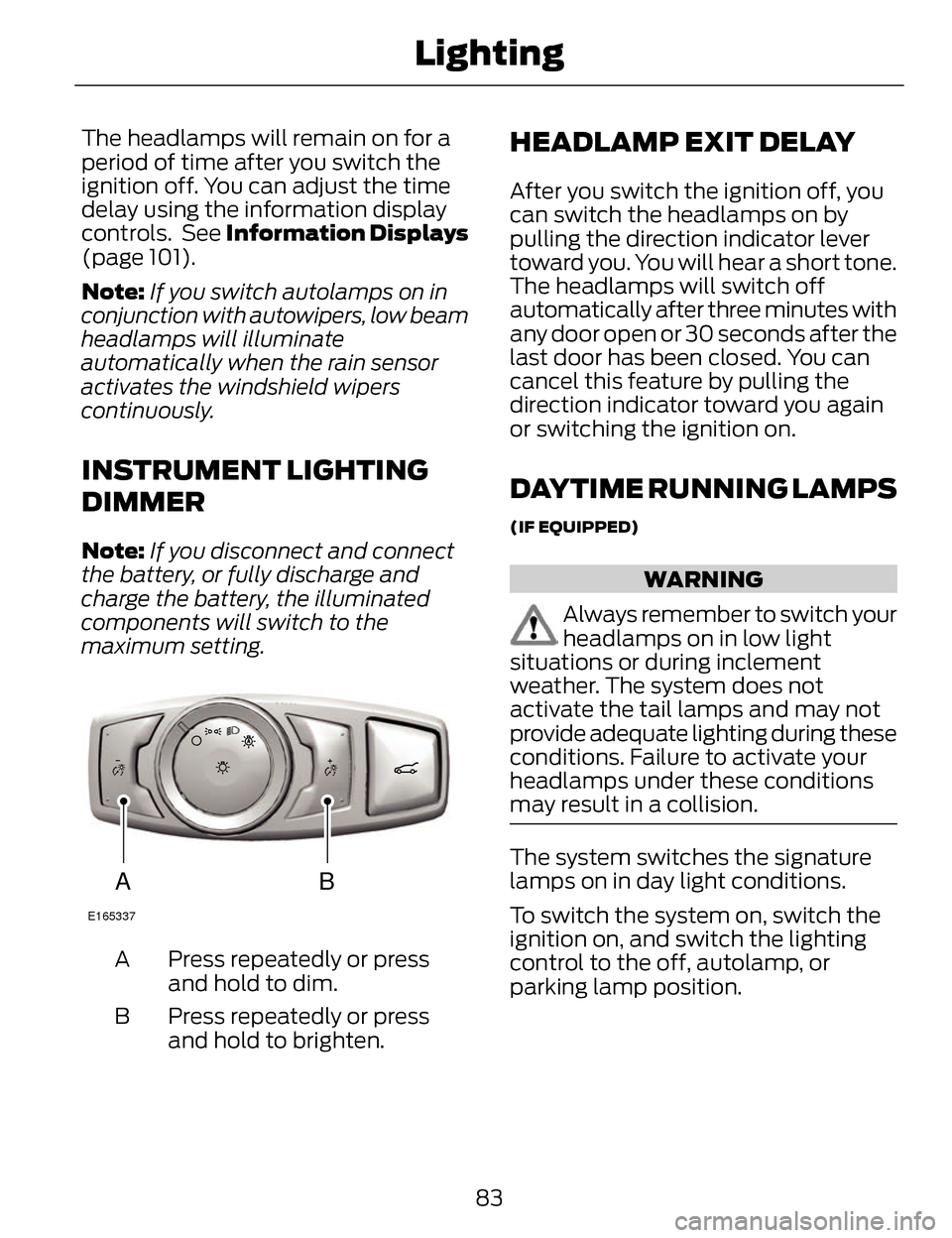
The headlamps will remain on for a
period of time after you switch the
ignition off. You can adjust the time
delay using the information display
controls. See Information Displays
(page 101).
Note:If you switch autolamps on in
conjunction with autowipers, low beam
headlamps will illuminate
automatically when the rain sensor
activates the windshield wipers
continuously.
INSTRUMENT LIGHTING
DIMMER
Note: If you disconnect and connect
the battery, or fully discharge and
charge the battery, the illuminated
components will switch to the
maximum setting.
AB
E165337
Press repeatedly or press
and hold to dim.
A
Press repeatedly or press
and hold to brighten.
B
HEADLAMP EXIT DELAY
After you switch the ignition off, you
can switch the headlamps on by
pulling the direction indicator lever
toward you. You will hear a short tone.
The headlamps will switch off
automatically after three minutes with
any door open or 30 seconds after the
last door has been closed. You can
cancel this feature by pulling the
direction indicator toward you again
or switching the ignition on.
DAYTIME RUNNING LAMPS
(IF EQUIPPED)
WARNING
Always remember to switch your
headlamps on in low light
situations or during inclement
weather. The system does not
activate the tail lamps and may not
provide adequate lighting during these
conditions. Failure to activate your
headlamps under these conditions
may result in a collision.
The system switches the signature
lamps on in day light conditions.
To switch the system on, switch the
ignition on, and switch the lighting
control to the off, autolamp, or
parking lamp position.
83
Lighting
Page 87 of 468
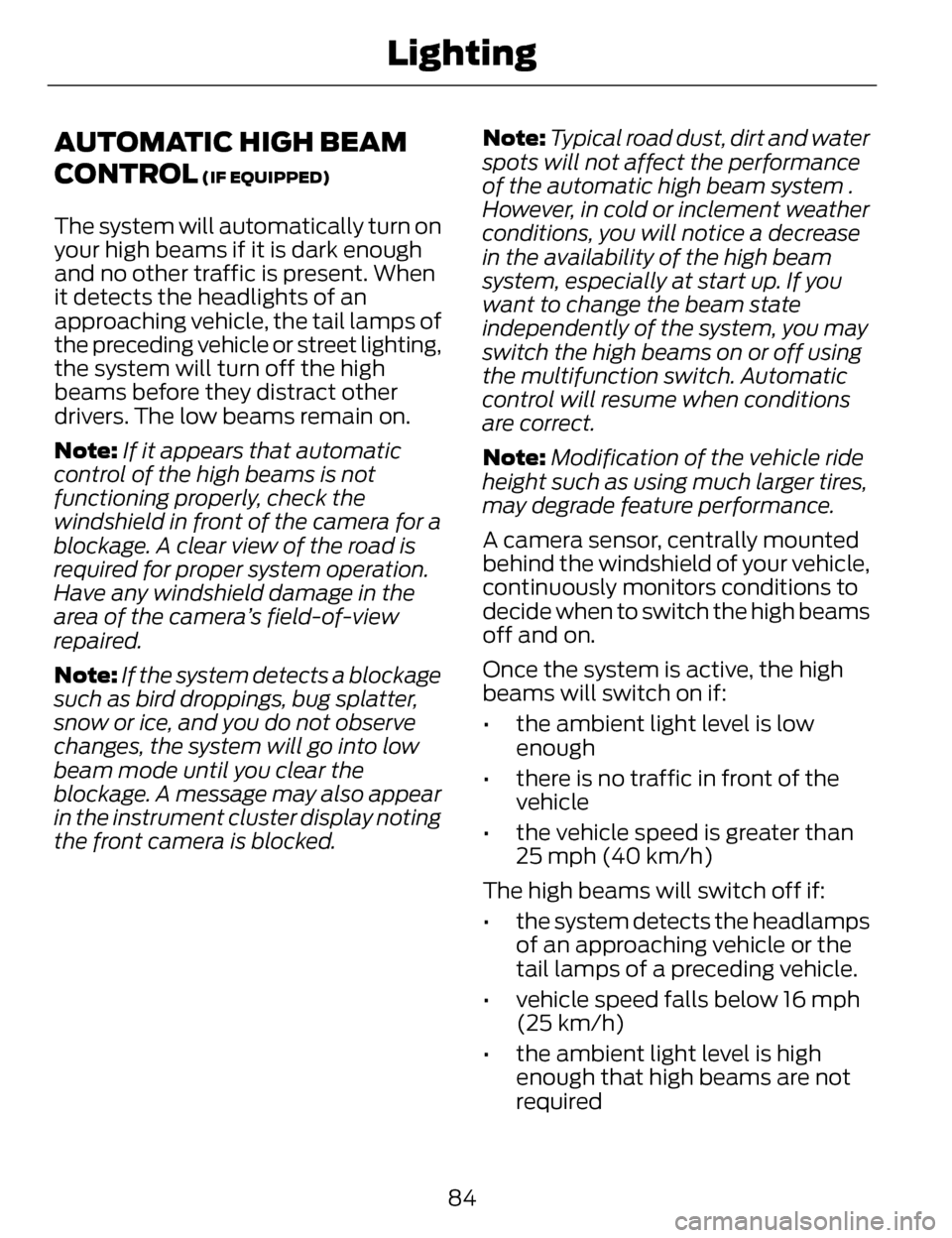
AUTOMATIC HIGH BEAM
CONTROL
(IF EQUIPPED)
The system will automatically turn on
your high beams if it is dark enough
and no other traffic is present. When
it detects the headlights of an
approaching vehicle, the tail lamps of
the preceding vehicle or street lighting,
the system will turn off the high
beams before they distract other
drivers. The low beams remain on.
Note:If it appears that automatic
control of the high beams is not
functioning properly, check the
windshield in front of the camera for a
blockage. A clear view of the road is
required for proper system operation.
Have any windshield damage in the
area of the camera’s field-of-view
repaired.
Note: If the system detects a blockage
such as bird droppings, bug splatter,
snow or ice, and you do not observe
changes, the system will go into low
beam mode until you clear the
blockage. A message may also appear
in the instrument cluster display noting
the front camera is blocked. Note:
Typical road dust, dirt and water
spots will not affect the performance
of the automatic high beam system .
However, in cold or inclement weather
conditions, you will notice a decrease
in the availability of the high beam
system, especially at start up. If you
want to change the beam state
independently of the system, you may
switch the high beams on or off using
the multifunction switch. Automatic
control will resume when conditions
are correct.
Note: Modification of the vehicle ride
height such as using much larger tires,
may degrade feature performance.
A camera sensor, centrally mounted
behind the windshield of your vehicle,
continuously monitors conditions to
decide when to switch the high beams
off and on.
Once the system is active, the high
beams will switch on if:
• the ambient light level is low enough
• there is no traffic in front of the vehicle
• the vehicle speed is greater than 25 mph (40 km/h)
The high beams will switch off if:
• the system detects the headlamps of an approaching vehicle or the
tail lamps of a preceding vehicle.
• vehicle speed falls below 16 mph (25 km/h)
• the ambient light level is high enough that high beams are not
required
84
Lighting
Page 94 of 468
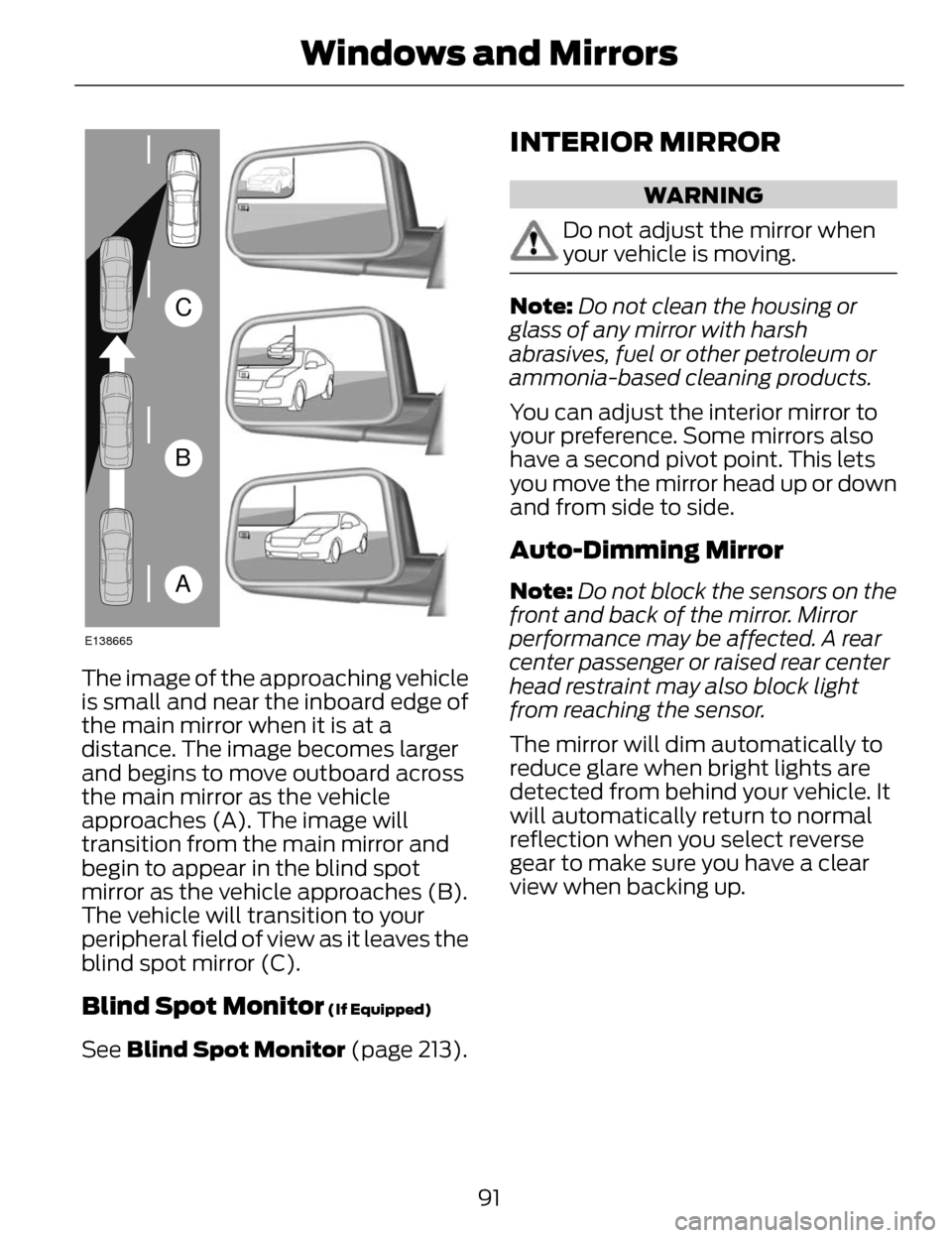
A
B
C
E138665
The image of the approaching vehicle
is small and near the inboard edge of
the main mirror when it is at a
distance. The image becomes larger
and begins to move outboard across
the main mirror as the vehicle
approaches (A). The image will
transition from the main mirror and
begin to appear in the blind spot
mirror as the vehicle approaches (B).
The vehicle will transition to your
peripheral field of view as it leaves the
blind spot mirror (C).
Blind Spot Monitor (If Equipped)
See Blind Spot Monitor (page 213).
INTERIOR MIRROR
WARNING
Do not adjust the mirror when
your vehicle is moving.
Note:Do not clean the housing or
glass of any mirror with harsh
abrasives, fuel or other petroleum or
ammonia-based cleaning products.
You can adjust the interior mirror to
your preference. Some mirrors also
have a second pivot point. This lets
you move the mirror head up or down
and from side to side.
Auto-Dimming Mirror
Note: Do not block the sensors on the
front and back of the mirror. Mirror
performance may be affected. A rear
center passenger or raised rear center
head restraint may also block light
from reaching the sensor.
The mirror will dim automatically to
reduce glare when bright lights are
detected from behind your vehicle. It
will automatically return to normal
reflection when you select reverse
gear to make sure you have a clear
view when backing up.
91
Windows and Mirrors
Page 109 of 468
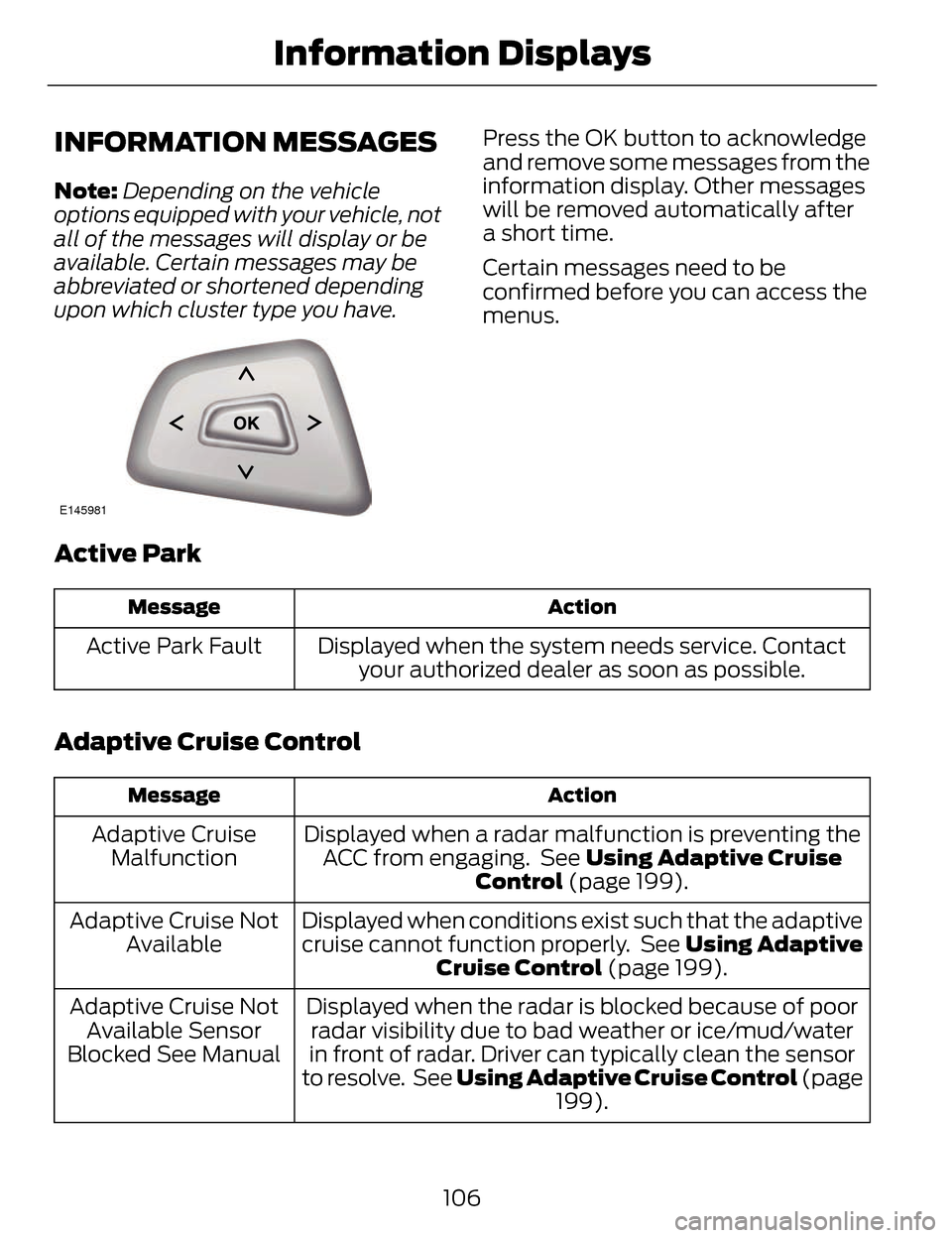
INFORMATION MESSAGES
Note:Depending on the vehicle
options equipped with your vehicle, not
all of the messages will display or be
available. Certain messages may be
abbreviated or shortened depending
upon which cluster type you have.
E145981
Press the OK button to acknowledge
and remove some messages from the
information display. Other messages
will be removed automatically after
a short time.
Certain messages need to be
confirmed before you can access the
menus.
Active Park
Action
Message
Displayed when the system needs service. Contact
your authorized dealer as soon as possible.
Active Park Fault
Adaptive Cruise Control
Action
Message
Displayed when a radar malfunction is preventing the
ACC from engaging. See Using Adaptive Cruise Control (page 199).
Adaptive Cruise
Malfunction
Displayed when conditions exist such that the adaptive
cruise cannot function properly. See Using Adaptive
Cruise Control (page 199).
Adaptive Cruise Not
Available
Displayed when the radar is blocked because of poorradar visibility due to bad weather or ice/mud/water
in front of radar. Driver can typically clean the sensor
to resolve. See Using Adaptive Cruise Control (page 199).
Adaptive Cruise Not
Available Sensor
Blocked See Manual
106
Information Displays
Page 110 of 468
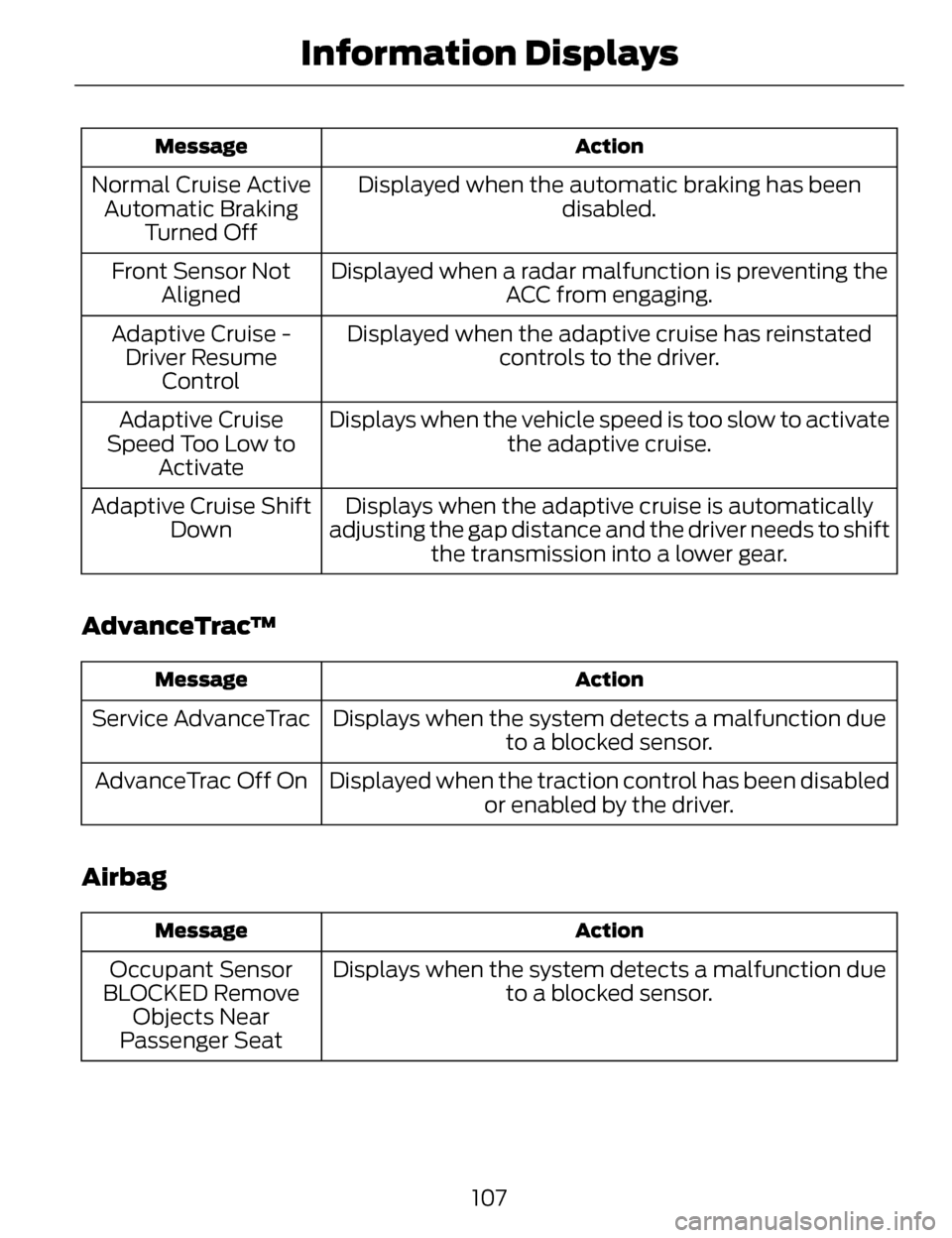
Action
Message
Displayed when the automatic braking has been
disabled.
Normal Cruise Active
Automatic Braking Turned Off
Displayed when a radar malfunction is preventing theACC from engaging.
Front Sensor Not
Aligned
Displayed when the adaptive cruise has reinstatedcontrols to the driver.
Adaptive Cruise -
Driver Resume Control
Displays when the vehicle speed is too slow to activate the adaptive cruise.
Adaptive Cruise
Speed Too Low to Activate
Displays when the adaptive cruise is automatically
adjusting the gap distance and the driver needs to shift the transmission into a lower gear.
Adaptive Cruise Shift
Down
AdvanceTrac™
Action
Message
Displays when the system detects a malfunction due
to a blocked sensor.
Service AdvanceTrac
Displayed when the traction control has been disabledor enabled by the driver.
AdvanceTrac Off On
Airbag
Action
Message
Displays when the system detects a malfunction due
to a blocked sensor.
Occupant Sensor
BLOCKED Remove Objects Near
Passenger Seat
107
Information Displays
Page 114 of 468
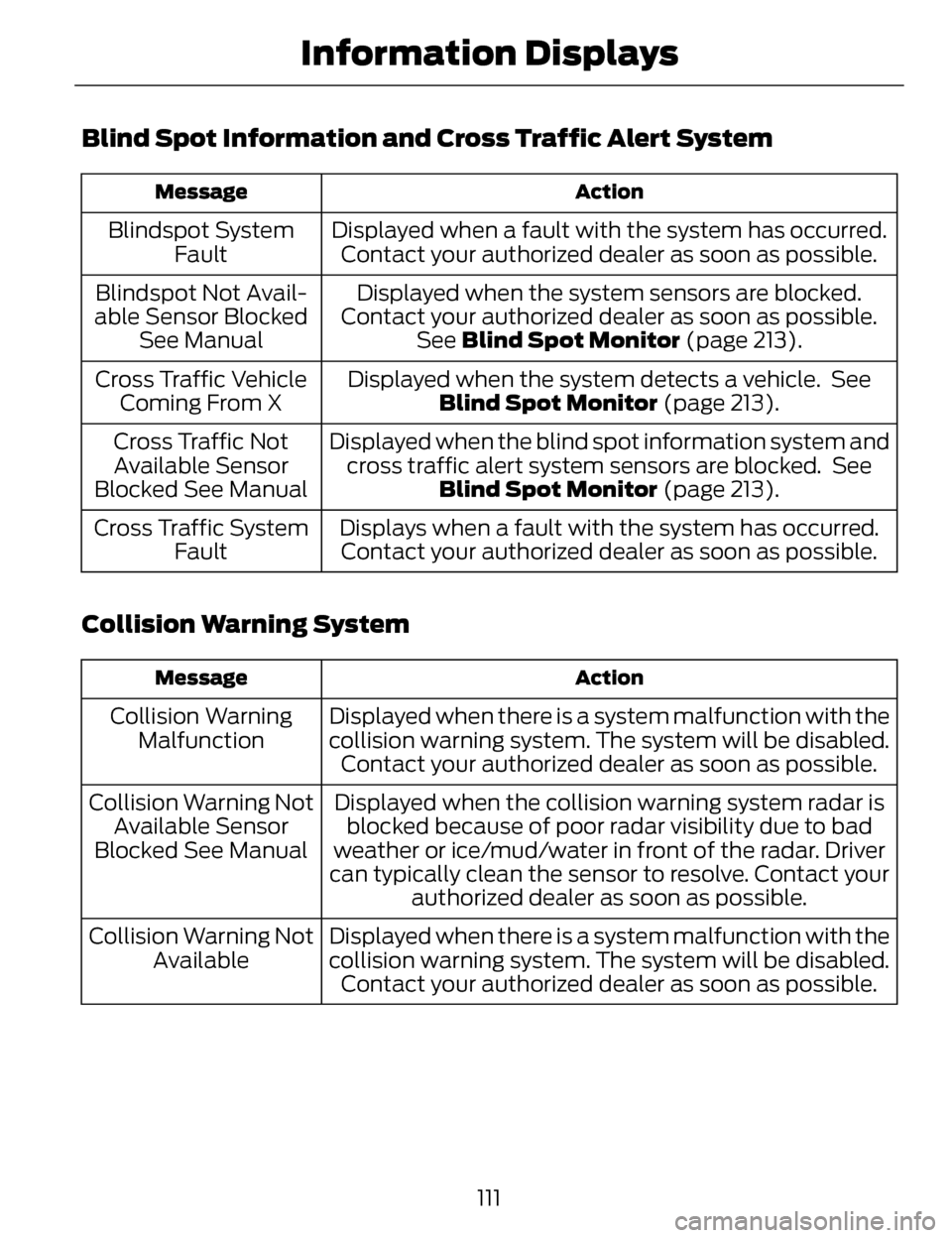
Blind Spot Information and Cross Traffic Alert System
Action
Message
Displayed when a fault with the system has occurred.
Contact your authorized dealer as soon as possible.
Blindspot System
Fault
Displayed when the system sensors are blocked.
Contact your authorized dealer as soon as possible. See Blind Spot Monitor (page 213).
Blindspot Not Avail-
able Sensor Blocked See Manual
Displayed when the system detects a vehicle. SeeBlind Spot Monitor (page 213).
Cross Traffic Vehicle
Coming From X
Displayed when the blind spot information system andcross traffic alert system sensors are blocked. See Blind Spot Monitor (page 213).
Cross Traffic Not
Available Sensor
Blocked See Manual
Displays when a fault with the system has occurred.Contact your authorized dealer as soon as possible.
Cross Traffic System
Fault
Collision Warning System
Action
Message
Displayed when there is a system malfunction with the
collision warning system. The system will be disabled.
Contact your authorized dealer as soon as possible.
Collision Warning
Malfunction
Displayed when the collision warning system radar isblocked because of poor radar visibility due to bad
weather or ice/mud/water in front of the radar. Driver
can typically clean the sensor to resolve. Contact your authorized dealer as soon as possible.
Collision Warning Not
Available Sensor
Blocked See Manual
Displayed when there is a system malfunction with the
collision warning system. The system will be disabled.Contact your authorized dealer as soon as possible.
Collision Warning Not
Available
111
Information Displays